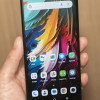Hands-On: HTC Status
Jul 12, 2011, 4:06 PM by Eric M. Zeman
AT&T had a small gathering for media in New York City today and was showing off a number of products in has announced in recent weeks. One of those devices was the HTC Status and we took a look.
THe HTC Status was first announced in February of this year as the ChaCha. The phone, to be available from AT&T starting in July 27, was on hand at AT&T's event today and we spent a few moments with it.
It is a small device, compact, and has a pleasing angle to the body. The surfaces are a typical blend of metal, glass, and plastic for which HTC is known, and the manufacture, while not the best I've seen, was nice and sturdy. I really like the overall feel of the phone.
The display is a bit small. For anyone use to the full-sized screens of HTC's other Android devices, the Status will surely disappoint in this respect. That said, it is still bright, colorful, and produces sharp images and text.
There are the standard four Android control keys below it, all of which are capacitive. They worked well.
The QWERTY keyboard is one of the best I've seen from HTC in a long time. I prefer the portrait-style keyboard to the sideways-slider style keyboard, and I found the Status's very appealing. The buttons are well-spaced, have a good shape to them, and offer excellent travel and feedback.
In standard HTC form, the volume toggle is a teensy sliver of plastic on the left side of the phone. It has acceptable travel and feedback. There are no controls on the right edge. The top houses the power/lock key and the 3.5mm headset jack is next to it. The microUSB port is on the bottom edge.
HTC has done its best to stuff the Android user interface and its Sense overlay into the small screen. It has done an admirable job, but the experience definitely suffers when compared to the Status's more full-screened brothers. Even so, the UI was speedy, intuitive, and peppered with thoughtful shortcuts and such to make dealing with the reduced real estate a bit less painful.
What's most interesting about the Status is how HTC decided to make use of the dedicated Facebook button. The Facebook button interacts with what the user is doing. So, say I am listening to some Foo Fighters. If I press the Facebook button while in the music player, it will push the song to my Facebook page and let everyone know what I am listening to. Similarly, if I've just taken an amazing photograph and then press the Facebook button, it will automatically send the image to my Facebook page. It performs like this with web sites, check-ins and more.
HTC also customized its Sense user interface to interact with Facebook posts more seamlessly. For example, users' most recent posts appear in the clock widget on the home page, so you can see what you last shared.
These are neat innovations, to be sure, and we're anxious to spend some real time with the Status.
Comments
Pretty cool...

















 Samsung Refreshes Galaxy S Series with S Pen, New Cameras
Samsung Refreshes Galaxy S Series with S Pen, New Cameras
 Samsung Refines its Foldable Phones
Samsung Refines its Foldable Phones
 iPhone 14 Plus Offers a Big Screen For Less
iPhone 14 Plus Offers a Big Screen For Less
 TCL's Newest Concept Phone has a Matte Screen
TCL's Newest Concept Phone has a Matte Screen
 Hands On with the TCL 50 XE NXTPAPER 5G
Hands On with the TCL 50 XE NXTPAPER 5G



